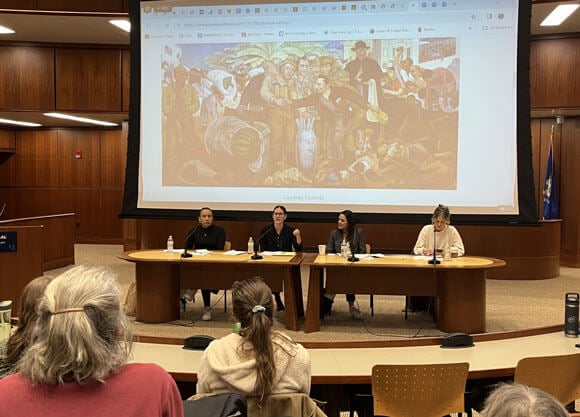
Discussion considers best ways of protecting, assisting immigrant children
February 29, 2024

February 29, 2024

The February 23 panel discussion “Protecting Immigrant Children: Their Journeys Before and After They Reach the U.S.” was hosted by Quinnipiac’s Human Trafficking Prevention Project (HTPP), along with the Connecticut Bar Association and the Connecticut Bar Foundation.
The panel convened during Human Trafficking Prevention Project's fifth annual awareness week. The week-long series explores the interactions between trafficking victims and the legal system and delves into ongoing debates at the state and federal levels about what reforms are needed to assist victims in escaping trafficking, rebuilding their lives and preventing trafficking.
Sheila Hayre, clinical professor of Law and faculty adviser for the Quinnipiac Human Trafficking Prevention Project, introduced the panel to attendees at the university's ceremonial courtroom on the North Haven Campus.
“They exemplify the compassion, the drive, and the life dedication to working with kids like this, and to this kind of work,” said Hayre.
Kids in Need of Defense international program staff attorney Lesly Tayes, managing director Emily Norman, and senior attorney Tess Regan, together with Aniosca Cortina of the Unaccompanied Children Program, Connecticut Institute for Refugees and Immigrants, comprised the panel. Regan moderated the discussion.
Each year, thousands of unaccompanied migrant children from Central America arrive in the U.S. without their families. The panel explored why these children come, and how they are processed and resettled across the country. They also discussed the struggles to regularize their immigration status in the U.S., and shared insight on the need to build pathways to allow these children to immigrate legally from their countries before they even leave them.
In recent years, the U.S. has seen an influx of unaccompanied children from Central America fleeing violence and extreme poverty in their home countries. Children assisted by the Connecticut Institute for Refugees and Immigrants have been primarily arriving from Guatemala, Honduras, and El Salvador, as well as some from Venezuela, said Cortina.
“These children are coming over for myriad reasons,” said Cortina. “Some are stories I would have a difficult time repeating. The majority are fleeing from violence. They are struggling to find food in their home countries. Some have had to leave school in their home country to be responsible for providing for their families.”
Norman said there has been a steadily growing increase in the number of young unaccompanied children under the age of 10.
“Unaccompanied minors have been coming to the United States for many years, but as a result of some of the more restrictive policies at the border that make it really difficult for family units to enter together, we’ve started to see younger and younger children coming across alone,” said Norman. “Because the adults are being locked out, they make the very difficult and gut-wrenching decision to send their child ahead, because unaccompanied children cannot be sent back across the border.”
For many Americans, it is difficult to understand what circumstances cause a child to leave their home and family behind and enter a foreign country on their own. Sharing stories of children and families they’ve assisted; the panel provided an in-depth look into the reasons for the flight of these children away from their countries of origin, and their journeys into the U.S.
Distinctions between smuggling and trafficking, and the blurred lines which sometimes allow smuggling to become trafficking, were also discussed by the panel.
“Often, we want to say something is black and white, that there’s a very clear distinction,” said Regan. “But there just isn’t. These cases are more complex. Each case is unique, each situation is unique. It’s very moving to hear these stories — and also to hear the panel dispel some common misconceptions of these children and how they come here.”
Tayes, who works closely with Guatemalan families and children, said there are several difficult drivers compelling the children to leave their home country.
“People migrate because they need food, they need safety or education,” said Tayes. “I have cases in which the parents gave their children to an uncle, or to a neighbor, or a smuggler. In many cases, the smugglers, or ‘coyotes’ are community leaders, so they trust their children will find a job here in the U.S. and provide for them in their home country. Because in Guatemala, when they are 14 years old, they have to stop studying and go to work, to provide for their families.”
These desperate family circumstances often foster systems of exploitation, Regan added.
“Something we all hear frequently is a system of exploitation, where you have a system set up that understands the desperation of a lot of families and a lot of children, and using that to say, ‘Here’s the avenue I can create for you to get to the U.S.,’” said Regan.
The panel also spoke to the struggle to regularize children’s immigration status in this country and provided insight into pathways that can be developed for these children to immigrate legally before they even leave home.
Regan said greater awareness of the varying individual stories and circumstances involved in the unaccompanied migration of these children to the U.S. can foster greater compassion and action.
“I think the reason why panels like this are so important is because a lot of people don’t understand the realities, and don’t understand the nuances of the situation,” Regan said. “The more people understand, and the more information people have, the better tools you have to try to assert your influence, whether that is communication with your congressional representatives or engaging in other advocacy.”
Quinnipiac Today is your source for what's happening throughout #BobcatNation. Sign up for our weekly email newsletter to be among the first to know about news, events and members of our Bobcat family who are making a positive difference in our world.
Sign Up Now